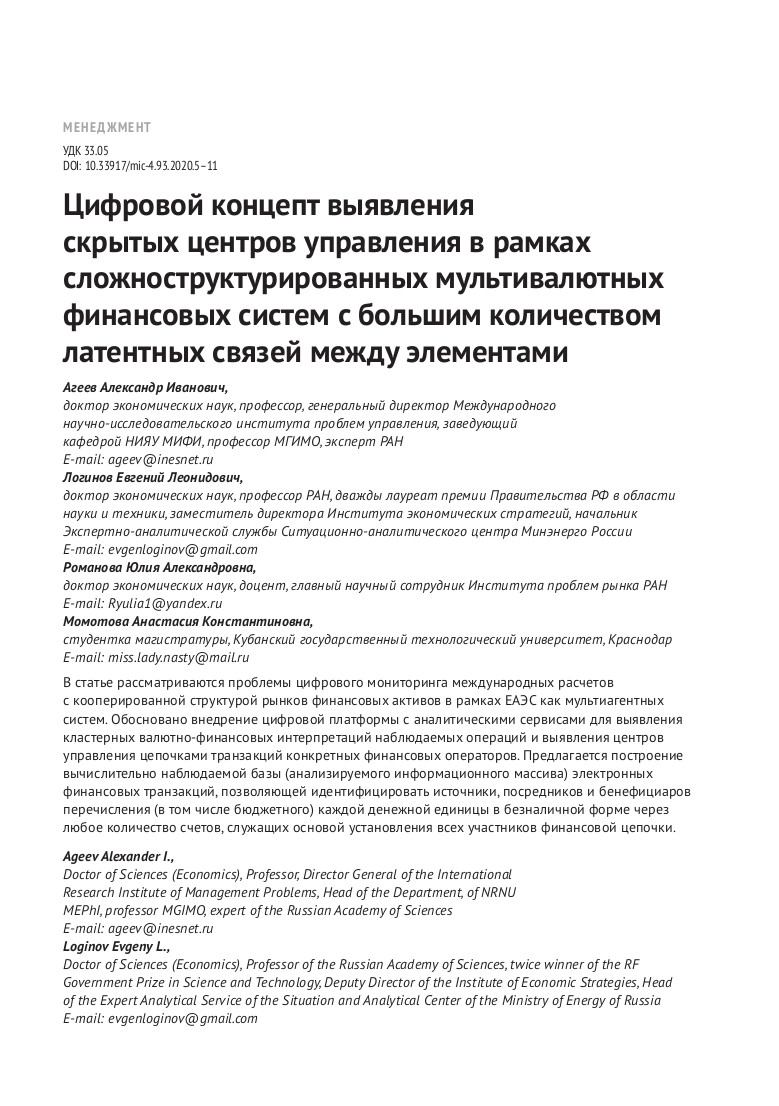Self-similar Attractors of the Historical Process as Observable “Laws of Nature and Society”
DOI: 10.33917/es-3.189.2023.94-103
The author dwells on self-similar factors that have regulated, regulate and in the nearest future will regulate sociohistorical processes. The old regulation methods, which have been characteristic of the planet and societ y’s biosphere for billions of years, are losing their dominance. This is expressed as a “crisis of crises”. New regulation methods have already begun to emerge in the historical process, but the final transition of societ y to the next stage of development will take place only after the singularity, that is, after a radical change in the principles, scales and dimensions of development. The main features of the new regulation methods are the reasonable exogenous development of our civilization, which can become an element of large space systems.
References:
1. Panov A.D. Krizis planetarnogo tsikla universal’noi istorii [Crisis of the Planetary Cycle of Universal History]. Moscow, NIIYaF MGU, 2005.
2. Nazaretyan A.P. Nelineinoe budushchee: megaistoricheskie, sinergeticheskie i kul’turno-psikhologicheskie predposylki global’nogo prognozirovaniya [Non-Linear Future: Mega-Historical, 3. Synergetic and Cultural-Psychological Prerequisites for Global Forecasting]. Institut vostokovedeniya RAN. Moscow, Izd-vo MBA, 2013, p. 303.
3. Sudakov K.V. Izbrannye trudy [Selected Works]. Moscow, GU NII normal’noi fiziologii im. P.K. Anokhina RAMN, 2007, vol 1. Razvitie teorii funktsional’nykh system, Moscow, 2007, pp. 233, 234.
4. Snooks G.D. The dynamic society. Exploring the source of global change. L. — N.Y., Routledge, 1996.
5. Panov A.D. Universal’naya evolyutsiya i problema poiska vnezemnogo razuma (SETI) [Universal Evolution and the Search for Extraterrestrial Intelligence (SETI) Problem]. Moscow, Izd-vo LKI, 2008, 208 p. (Sinergetika v gumanitarnykh naukakh.)
6. Est’ li budushchee u nauki: Interv’yu S.P. Kurdyumova i G.G. Malinetskogo o regulyatsii slozhnykh sistem [Is There a Future for Science: Interview with S.P. Kurdyumov and G.G. Malinetsky on the regulation of complex systems]. YouTube. Programma «Gordon» («Dialogi»), available at: https://youtu.be/DueTp7idhUo.
7. Kara-Murza S.G. Nauka kak koren’ Rossii [Science as a Root of Russia]. Razvitie i ekonomika: Al’manakh, available at: http://devec.ru/almanah/7/1426-sergej-kara-murza-nauka-kakkoren-rossii.ht.
8. Ovchinskii V., Larina E. Kholodnaya voina 2.0: Doklad Izborskomu klubu [Cold War 2.0: Report to the Izborsk Club]. Izborskii klub, available at: ht tp:// www.dynacon.ru/content/articles/4224/
9. Konets Istorii. Chto takoe singulyarnost’ i nado li ee boyat’sya? Interv’yu K. Frumkina S. Medvedevu [End of History. What is the Singularity and Should We be Afraid of it? Interview of K. Frumkin to S. Medvedev]. Radio Svoboda, available at: ht tp://www.svoboda.org/a/27934174.html.
10. Malinetskii G.G., Potapov A.B. Dzhokery, rusla ili poiski tret’ei paradigmy [Jokers, Channels or Search for the Third Paradigm]. Sinergeticheskaya paradigma. Moscow, 2000, Sait S.P. Kurdyumova “Sinergetika”, available at: http://spkurdyumov.ru/introduction/dzhokery-rusla/





